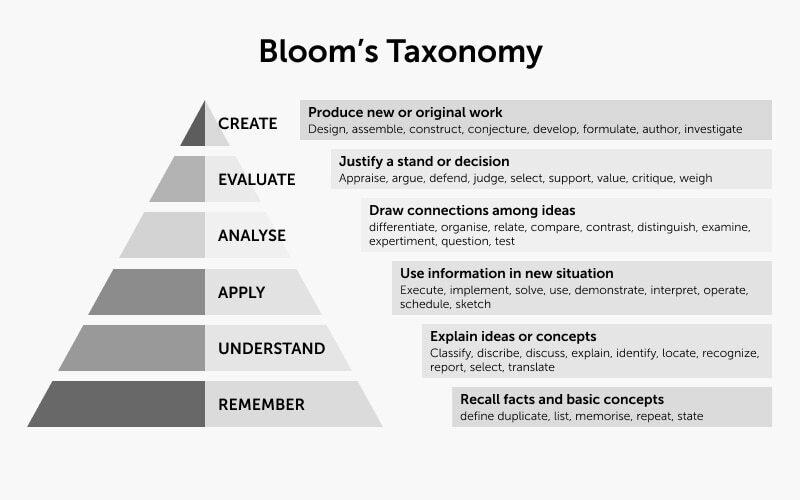Introduction
Bloom’s Taxonomy is a powerful mental model that categorizes cognitive processes involved in learning and decision-making. Anchored in human psychology, this model provides a framework for understanding and improving critical thinking skills. By applying Bloom’s Taxonomy, individuals can enhance their decision-making abilities, overcome biases, and make more informed choices.
Defining Bloom’s Taxonomy and Its Relevance
Bloom’s Taxonomy classifies cognitive processes into six hierarchical levels, ranging from lower-order thinking skills (remembering and understanding) to higher-order thinking skills (applying, analyzing, evaluating, and creating). This model is relevant in decision-making processes as it encourages individuals to move beyond surface-level understanding and engage in critical thinking and problem-solving.
The prevalence of Bloom’s Taxonomy in our day-to-day lives is evident in various contexts, including personal life decisions, business scenarios, and public policy-making. By embracing this model, individuals can avoid the pitfall of relying solely on basic knowledge and engage in deeper analysis and evaluation, leading to more rational decisions.
Examples of Bloom’s Taxonomy in Various Contexts
- Personal Life Decisions: Consider a person making a career choice. At the lower level of Bloom’s Taxonomy, they may start by remembering and understanding basic information about different professions. However, by utilizing higher-level thinking skills, such as analyzing the job market, evaluating their interests and skills, and creating a plan for career development, they can make a more informed and fulfilling career decision.
- Business Scenarios: In a business setting, Bloom’s Taxonomy is crucial for strategic decision-making. For instance, when launching a new product, a company must apply the knowledge of customer preferences and market trends (applying). They then analyze the product’s performance data, customer feedback, and market research (analyzing) to evaluate its success. Finally, they can make informed decisions about modifications, expansions, or discontinuation (evaluating and creating) based on the outcomes.
- Public Policy-Making: Bloom’s Taxonomy also applies to public policy-making. Policymakers must move beyond simply understanding the issues at hand. They need to apply their knowledge to analyze the impacts of various policy options, evaluate their effectiveness, and create new policies that address societal needs. By utilizing higher-order thinking skills, policymakers can develop more comprehensive and well-informed public policies.
Mental Biases and Psychological Underpinnings
Several cognitive biases can hinder the application of Bloom’s Taxonomy. Confirmation Bias, for example, can prevent individuals from objectively evaluating and analyzing information that contradicts their existing beliefs or preferences. Availability Heuristic may limit individuals to rely on readily available information rather than conducting in-depth analysis and evaluation. Overconfidence Bias can lead to an inflated sense of competence in understanding complex issues, hindering the use of higher-order thinking skills.
Practical Strategies for Identifying and Avoiding Bloom’s Taxonomy Biases
To avoid falling prey to Bloom’s Taxonomy biases, consider the following strategies:
- Embrace Metacognition: Develop awareness of your thinking processes and biases. Reflect on your own thinking and decision-making patterns, and actively seek to challenge and improve your cognitive abilities.
- Seek Diverse Perspectives: Engage in dialogue with people who have different viewpoints or expertise. Actively listen to alternative perspectives, encouraging critical thinking and broadening your understanding of complex issues.
- Engage in Reflective Practice: Regularly reflect on your decisions and actions. Analyze the outcomes and identify areas for improvement. Continuously seek feedback and be open to constructive criticism to enhance your evaluative skills.
- Develop Analytical Tools: Learn and apply analytical frameworks and tools such as SWOT analysis, cost-benefit analysis, and decision trees. These tools provide structured approaches to decision-making, ensuring you engage in higher-level thinking processes.
Conclusion
Bloom’s Taxonomy serves as a valuable mental model for decision-making, allowing individuals to transcend surface-level understanding and engage in higher-level thinking. By recognizing and addressing biases, individuals can make more informed and rational choices across various contexts. Embracing metacognition, seeking diverse perspectives, engaging in reflective practice, and utilizing analytical tools are practical strategies to enhance decision-making abilities. The implications of Bloom’s Taxonomy extend to personal, business, and public policy domains, emphasizing the importance of actively avoiding mental traps and embracing critical thinking for optimal outcomes.
